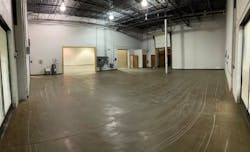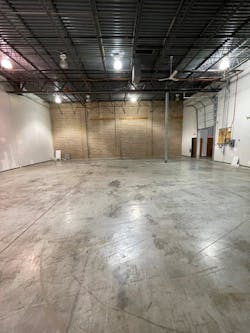By Karen Hanna
The movement of manufacturing jobs is typically read from West to East, with plants in the U.S. closing and production moving offshore.
But, for one mold maker based in the U.S., finding a balance has meant creating jobs here.
As an unprecedented labor shortage continues to lock up the supply chain, Jade Molds is hiring here to ensure its North American customers have easier access to its services. With most of its manufacturing guided by Western requirements in China, with U.S.-based engineers that oversee all engineering, the company is expanding to give its customers more options, Jade marketing manager Gary Moran said.
“We're reshoring in bricks and mortar, and giving people the option of, if you want a USA-built mold, we can build you a USA mold. But if you need that China[-built] price to compete, we can do that for you, too,” Moran said.
He spoke in the fall, a couple months before the company’s newest facility — in Jackson, Wis. — was slated to join locations in China and India in offering mold-design services. He said it could begin making molds around late December or January. An American company, Jade has always strived to meet the needs of injection molders in the U.S., Moran said.
“In China, we've got over 50 people working in the factory. We’ve got three or four key Western managers in there who oversee every critical aspect of a mold build and the testing phase, the samples, sample runs, QC parts, and we have an engineering office in India with about 15 people right now that we continue to staff up there, and they work to support our USA engineers,” he said.
Depending on market demands and mold requirements, Jade customers might split their orders among the locations, said Moran, a native Canadian who’s based in Thailand.
“A lot of people in any industry would prefer to manufacture in their home country if they can, and when they can, they can, and when they can't because the market won't let them, they look for offshoring. … But you get the benefit of the China mold when it's an offshore mold, and when not, it's going be made right there in Wisconsin for you,” he said.
“They'll do more designs, they'll do DFM [design-for-manufacturing] reviews, they'll do deeper Moldex3D, you know, like, Level 3 Moldex3D, if you need to those kinds of things,” Moran said.
He anticipates the Wisconsin plant’s staff will number about 10 over the next year or so, including two engineers, an engineer-manager, two or three toolmakers, a sales representative and two other workers.
With resources available in India and China, Moran indicated that finding workers shouldn’t be a problem.
“We've looked in the market to say we believe there's enough people that we could get to scale up; we're not really worried about that,” Moran said.
One key to the company’s approach to dealing with labor issues is a Hermle C400 five-axis CNC machining center, said Matt Sweeney, the VP of engineering for Jade Molds USA, who will head up the Wisconsin facility. Compared with three-axis machines, five-axis machines are more efficient, so shops that use them can do more with fewer people.
“Frankly, the people that have developed these skills are set to retire in the next 10 years with a large generational gap of [skilled] trades behind them not able to fill in their place. The alternative is to invest in high-tolerance machines, such as a Hermle five-axis so we can outpace the labor issues,” he said.
Hermle machines can cut to within 0.00005 inch and can run lights-out, repeatably, without supervision, he said.
“With this level of accuracy, we are able to cut the steel to the 3D CAD numbers, so it fits together perfectly when it comes out of the machine, in essence taking out the majority of the toolmaker ‘magic’ out of the process that we are not able to get anyway due to shifting market skillsets,” Sweeney said.
The Hermle will be among the first pieces of equipment at the Wisconsin facility, along with a Mitsubishi EA 12S electrical discharge machining center, a ProtoTrak DPM RX5 CNC machine and a Chevalier FSG-618M Grinder. Later acquisitions will include a Toyo Si-6 55T and Toyo Si-6 150T in Phase 2, and a Hermle C400 five-axis machining center and Toyo Si-6 400T in Phase 3, Sweeney said.
Like the Hermle machine, the Toyo injection molding machines — for sampling runs — offer worry-free production, Sweeney said.
“We can trust the machines to be repeatable every shot, and we will have RJG scientific mold recording data on every shot, analyzing and correcting the machines for exact, repeatable plastic parts every single time,” he said.
But, unlike some mold makers, Jade has no designs on moving into molding in its new 8,000-square-foot Wisconsin space, Moran said. The company primarily uses presses to perform sampling and low-volume part production in support of customers that need bridge production before the molds they’ve ordered are ready to go.
“Our big focus is really on mold building, mold making, compared to others that would get a giant space and focus on part production,” he said. “That’s not what we’re about. We’re not about cannibalizing our customers’ business; we’re about supporting them in the States.”
The option of having molds made in the U.S. or China allows customers to take advantage of either supply-chain efficiencies or lower prices to meet market demands.
“I love the term nearshoring,” Jade sales manager Mark Hill said. “I mean, produce the product where it's going to be sold, and big companies, they've been doing that for decades and decades. Building the brand, you want to build a gold global brand; you don't just want to keep it in one country.”
Hill said a recent discussion with a big molder illustrates the bump in credibility Jade stands to gain from its bigger U.S. presence.
“He says their company is actually, right now they've changed management, and they have a big push right now to find offshore mold-manufacturing plants. But they have to have, the requirement is they have to have an American tool shop,” he said. “He was very, very interested.”
With facilities in both hemispheres, the company will have the potential to offer the best of both worlds, according to Moran.
He conceded a fully American-built mold will cost more, but Jade’s contacts might enable it to source less-expensive, common components. Shortening the supply chain comes with its own rewards, though.
“But, if certain customers demand, ‘No, it needs to be these springs; it needs to be this [particular component] from this supplier,’ well, then that's what we can get, too, because the one thing that’s for sure in the States is the supply chain is quite easy, right?” Moran said.
Contact:
Jade Molds USA, Jackson, Wis., 888-549-6014, www.jademolds.com
About the Author
Karen Hanna
Senior Staff Reporter
Senior Staff Reporter Karen Hanna covers injection molding, molds and tooling, processors, workforce and other topics, and writes features including In Other Words and Problem Solved for Plastics Machinery & Manufacturing, Plastics Recycling and The Journal of Blow Molding. She has more than 15 years of experience in daily and magazine journalism.

